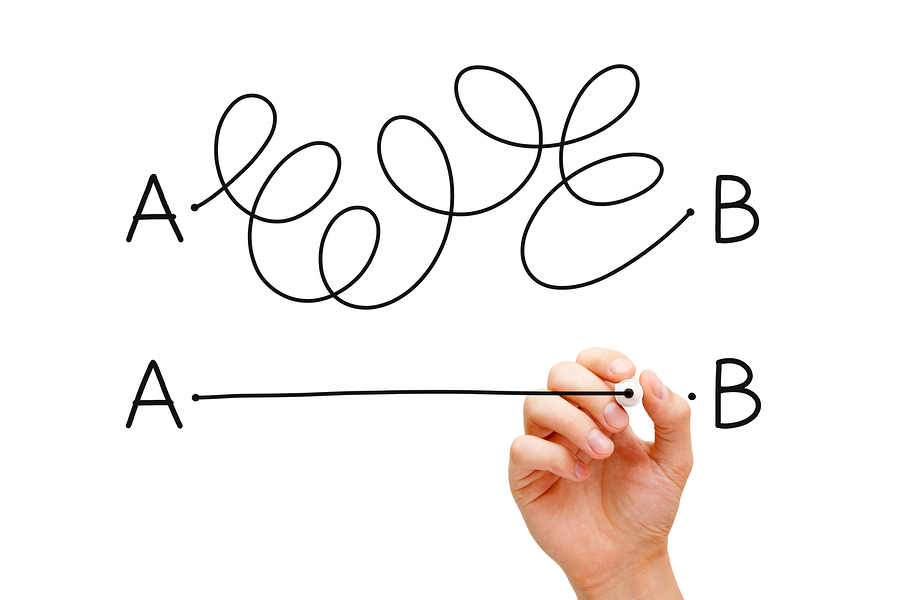When Shakespeare gave Hamlet his difficult soliloquy, he allowed some people to step back and view the play as a story of existential angst, while he left open the possibility that some would still judge it as a soap opera about a King of Denmark. Perhaps without this complicated speech, the simpler view of the play as just a soap opera would have prevailed and Hamlet might have faded into obscurity as just another afternoon melodrama.
Princeton researchers Alter and Oppenheimer [Psychological Science, 2007, Volume 19-Number 2, pages 161-167] have shown in several studies, with innovatively diverse approaches, that people will judge an issue differently based on the degree of simplicity of the message. They found . . .
- Complexity creates “psychological distance.” Psychological distance leads to abstract judgments [seeing the big picture].
- Simplicity creates “psychological closeness.” Psychological closeness leads to concrete judgments [focusing on detail].
For instance, if people are given information about going to the dentist in a complex format, they more often think of a dental visit in the abstract: a way of “practicing good oral hygiene.” When given the same dental information in a simple format, the subjects thought much more concretely about dental visits, as in “having one’s teeth drilled with a sharp metal object.”
It may be that complex messages require people to work hard to process the information, making it more comfortable for them to step back and just look at the big picture. Simple messages seem more “natural” or “intuitive” since understanding seems so “easy” or “automatic.”
How does this relate to your next trial?
- Look at your case and ask yourself, “Do I want the jury to see all the details or do I generally want them to think ‘we are the good guys’?”
- If the answer is “I want them to judge the details”, then you need to think in terms of being as simple in your presentation as possible.
- If the answer is “not all the facts really favor us, but overall we are right,” then incorporating some complexity might actually be a helpful strategy.
Let’s look at a typical insurance bad faith case as an example:
- Plaintiffs want the jury to look at a laundry-list of improper behavior by the carrier and eventually tie those together as malice, fraud, or oppression. This lends itself to being as simple as possible, tying each act into a coherent pattern of a carrier who is trying to save money by denying claims.
- Plaintiffs can set up the jury by opening with, “the defense might try to make this all really complicated, but if you look at the simple details, you’ll see how easy it is to come to a conclusion that their intention from the start was to not pay what they promised* to pay when we bought the policy . . .”
- The defense, on the other hand, might test out adding some complexity to the story. Explain how intricate policy language is, how difficult the laws governing insurance are, how these intricate rules and regulations can be interpreted in a variety of ways, and how interpretation 1 can be just as logical and unambiguous as interpretations 2, 3, 4, and 5 . . .
- The Defense can say, “it doesn’t really do justice to this case to oversimplify it: insurance is a complex industry regulated by complex laws and the only fair way to look at this case is within that backdrop. Like it or not, insurance is complex and, unfortunately, that complexity can create differences of opinion among hard-working people who are just trying to do a good job*.”
[*the ultimate concept you want to convey]
How do I begin the process of getting people to think the way I need them to? The research also shows that “priming” people with a simple or a complex task gets them to think that way towards the next task. So, going back to the bad faith example . . .
- Plaintiffs could prime the jury by saying, “Remember that old saying, ‘Where there is smoke, there is fire?’ Well this insurance case is nothing more than that. We’ll show you plenty of smoke that will make it easy for you to find the dangerous fire that burns below.” This old adage takes very little juror work to process. It is something they are close to—it is already in their minds before you say it. This now makes it easy for them to make your facts the smoke and their intuition then tells them there is surely something bad underneath.
- Defendants can prime the jury to make them be more skeptical thinkers. For instance, “You know, the easy way to look at our world hundreds of years ago was to say ‘the earth is flat and that the sun and all the stars revolve around it.’ What we know now, though, is that the earth is part of a much bigger system of very complex interactions and tremendous forces. Driving home tonight you’ll see some facts, like a fairly flat horizon and you’ll see that the sun as ‘moved’ from where it was this morning. Those might look like simple facts, but then you remember the universe, the complicated system we live in. This case is like that: insurance, just like the earth, operates in a very complex system and not everything is as it appears at first. You have to look at the evidence in the context of the whole complex system for it to make sense.”
Simple or complex? Your decision makes a difference.
Share This Story, Choose Your Platform!
Click below to add your email address to our mailing list and receive the latest Persuasion Tips right in your inbox!

